Integrating Communication and Sensor Arrays to Model and Navigate Autonomous Unmanned Aerial Systems
Abstract
1. Introduction
- In Section 2, we propose a mathematical model followed by an algorithm and flow chart to navigate a drone swarm using multi-beam beamforming decentralized antenna array systems.
- In Section 3, we present
- -
- the array received beamformed signals of drones in the drone swarm at time stamps and compare these received signals with output signals corresponding to a ground-truth action function having the same time stamps.
- -
- the analytical arithmetic complexity and numerical computational complexity of the proposed routing algorithm.
- -
- BER results based on the proposed AUAS swarm routing algorithm.
- In Section 4, we discuss an ML algorithm for the completion of spatial and temporal data to obtain the AUAS swarm routing algorithm followed by a low-cost algorithm.
- In Section 5, we conclude the paper.
2. MIMO Beamforming-Based Mathematical Model and Routing Algorithm to Navigate a Collection of AUAS
| Algorithm 1 Multi-beam beamforming-based AUAS swarm routing algorithm |
| Input: M, N, , and t. Output: . 1. for to M compute , , , and 2. for to M compute at t 3. for to M for to N for to M construct and end for i end for k end for u 4. return |
3. Results
3.1. Beamfomed Output of the AUAS Swarm Routing Model
3.2. Complexity of the AUAS Swarm Routing Algorithm
3.3. Bit-Error-Rate Based on the AUAS Swarm Routing Model
4. Discussion
5. Conclusions
Author Contributions
Funding
Institutional Review Board Statement
Informed Consent Statement
Data Availability Statement
Acknowledgments
Conflicts of Interest
Abbreviations
| AUAS | Autonomous Unmanned Aerial Systems |
| BER | Bit-error-rate |
| DNN | Deep neural network |
| ML | Machine learning |
| CSI | Channel state information |
| DSP | Digital signal processing |
| MUSIC | Multiple Signal Classification |
| ESPRIT | Estimation of Signal Parameters via Rotational Invariance Technique |
| AI | Artificial Intelligence |
| MIMO | Multiple-input multiple-output |
| AODV | ad-hoc on-demand distance vector |
References
- Chung, S.J.; Paranjape, A.A.; Dames, P.; Shen, S.; Kumar, V. A Survey on Aerial Swarm Robotics. IEEE Trans. Robot. 2018, 34, 837–855. [Google Scholar] [CrossRef]
- Tahir, A.; Böling, J.; Haghbayan, M.H.; Toivonen, H.T.; Plosila, J. Swarms of Unmanned Aerial Vehicles—A Survey. J. Ind. Inf. Integr. 2019, 16, 100106. [Google Scholar] [CrossRef]
- Elastic Tactical Networking for Autonomous Swarms. 2017. Available online: https://govtribe.com/opportunity/federal-contract-opportunity/elastic-tactical-networking-for-autonomous-swarms-fa875018s7004 (accessed on 4 January 2021).
- Huang, Y.; Wu, Q.; Wang, T.; Zhou, G.; Zhang, R. 3D Beam Tracking for Cellular-Connected UAV. IEEE Wirel. Commun. Lett. 2020, 9, 736–740. [Google Scholar] [CrossRef]
- Agiwal, M.; Roy, A.; Saxena, N. Next Generation 5G Wireless Networks: A Comprehensive Survey. IEEE Commun. Surv. Tutorials 2016, 18, 1617–1655. [Google Scholar] [CrossRef]
- Lin, Z.; Lin, M.; de Cola, T.; Wang, J.B.; Zhu, W.P.; Cheng, J. Supporting IoT With Rate-Splitting Multiple Access in Satellite and Aerial-Integrated Networks. IEEE Internet Things J. 2021, 8, 11123–11134. [Google Scholar] [CrossRef]
- Lin, Z.; Niu, H.; An, K.; Wang, Y.; Zheng, G.; Chatzinotas, S.; Hu, Y. Refracting RIS-Aided Hybrid Satellite-Terrestrial Relay Networks: Joint Beamforming Design and Optimization. IEEE Trans. Aerosp. Electron. Syst. 2022, 58, 3717–3724. [Google Scholar] [CrossRef]
- Huang, Q.; Lin, M.; Wang, J.B.; Tsiftsis, T.A.; Wang, J. Energy Efficient Beamforming Schemes for Satellite-Aerial-Terrestrial Networks. IEEE Trans. Commun. 2020, 68, 3863–3875. [Google Scholar] [CrossRef]
- Lin, Z.; Lin, M.; Zhu, W.P.; Wang, J.B.; Cheng, J. Robust Secure Beamforming for Wireless Powered Cognitive Satellite-Terrestrial Networks. IEEE Trans. Cogn. Commun. Netw. 2021, 7, 567–580. [Google Scholar] [CrossRef]
- An, K.; Liang, T. Hybrid Satellite-Terrestrial Relay Networks With Adaptive Transmission. IEEE Trans. Veh. Technol. 2019, 68, 12448–12452. [Google Scholar] [CrossRef]
- Jia, M.; Zhang, X.; Gu, X.; Guo, Q.; Li, Y.; Lin, P. Interbeam Interference Constrained Resource Allocation for Shared Spectrum Multibeam Satellite Communication Systems. IEEE Internet Things J. 2019, 6, 6052–6059. [Google Scholar] [CrossRef]
- Li, B.; Fei, Z.; Chu, Z.; Zhou, F.; Wong, K.K.; Xiao, P. Robust Chance-Constrained Secure Transmission for Cognitive Satellite–Terrestrial Networks. IEEE Trans. Veh. Technol. 2018, 67, 4208–4219. [Google Scholar] [CrossRef]
- Du, J.; Jiang, C.; Zhang, H.; Wang, X.; Ren, Y.; Debbah, M. Secure Satellite-Terrestrial Transmission Over Incumbent Terrestrial Networks via Cooperative Beamforming. IEEE J. Sel. Areas Commun. 2018, 36, 1367–1382. [Google Scholar] [CrossRef]
- Messous, M.A.; Arfaoui, A.; Alioua, A.; Senouci, S.M. A Sequential Game Approach for Computation-Offloading in an UAV Network. In Proceedings of the GLOBECOM 2017—2017 IEEE Global Communications Conference, Singapore, 4–8 December 2017; pp. 1–7. [Google Scholar] [CrossRef]
- Li, B.; Fei, Z.; Zhang, Y.; Guizani, M. Secure UAV Communication Networks over 5G. IEEE Wirel. Commun. 2019, 26, 114–120. [Google Scholar] [CrossRef]
- Zhou, F.; Hu, R.Q.; Li, Z.; Wang, Y. Mobile Edge Computing in Unmanned Aerial Vehicle Networks. IEEE Wirel. Commun. 2020, 27, 140–146. [Google Scholar] [CrossRef]
- Li, B.; Fei, Z.; Zhang, Y. UAV Communications for 5G and Beyond: Recent Advances and Future Trends. IEEE Internet Things J. 2019, 6, 2241–2263. [Google Scholar] [CrossRef]
- Secinti, G.; Darian, P.B.; Canberk, B.; Chowdhury, K.R. SDNs in the Sky: Robust End-to-End Connectivity for Aerial Vehicular Networks. IEEE Commun. Mag. 2018, 56, 16–21. [Google Scholar] [CrossRef]
- Sun, X.; Yang, W.; Cai, Y. Secure Communication in NOMA-Assisted Millimeter-Wave SWIPT UAV Networks. IEEE Internet Things J. 2020, 7, 1884–1897. [Google Scholar] [CrossRef]
- Restuccia, F.; Medlodia, T. Deep Learning at the Physical Layer: System Challenges and Applications to 5G and Beyond. IEEE Commun. Mag. 2020, 58, 58–64. [Google Scholar] [CrossRef]
- He, R.; Dingm, Z. (Eds.) Applications of Machine Learning in Wireless Communications; ProQuest Ebook Central, 2019. Available online: https://app.knovel.com/kn/resources/kpAMLWC004/toc (accessed on 20 August 2022).
- Eugenio, M.; Cayamcela, M.; Lee, H.; Lim, W. Machine Learning for 5G/B5G Mobile and Wireless Communications: Potential, Limitations, and Future Directions. IEEE Access 2019, 7, 137184–137206. [Google Scholar]
- Jagannath, J.; Polosky, N.; Jagannath, A.; Restuccia, F.; Melodia, T. Machine Learning Paradigms for Next-Generation Wireless Networks. IEEE Wirel. Commun. 2017, 24, 98–105. [Google Scholar]
- Jagannath, J.; Polosky, N.; Jagannath, A.; Restuccia, F.; Melodia, T. Machine learning for wireless communications in the Internet of Things: A comprehensive survey. Ad Hoc Netw. 2019, 93, 101913. [Google Scholar] [CrossRef]
- Wen, C.; Shih, W.; Jin, S. Deep learning for massive MIMO CSI feedback. IEEE Wireless Commun. Lett. 2018, 7, 748–751. [Google Scholar] [CrossRef]
- Jang, J.; Lee, H.; Hwang, S.; Ren, H.; Lee, I. Deep learning-based limited feedback designs for MIMO systems. IEEE Wireless Commun. Lett. 2020, 9, 558–561. [Google Scholar] [CrossRef]
- Lu, C.; Xu, W.; Shen, H.; Zhu, J.; Wang, K. MIMO channel information feedback using deep recurrent network. IEEE Commun. Lett. 2019, 23, 188–191. [Google Scholar] [CrossRef]
- Guo, J.; Yang, X.; Wen, C.; Jin, S.; Li, G. DL-based CSI feedback and cooperative recovery in massive MIMO. arXiv 2020, arXiv:2003.03303. [Google Scholar]
- Sohrabi, F.; Attiah, K.M.; Yu, W. Deep Learning for Distributed Channel Feedback and Multiuser Precoding in FDD Massive MIMO. arXiv 2020, arXiv:2007.06512v1. [Google Scholar] [CrossRef]
- Schmidt, R. Multiple emitter location and signal parameter estimation. IEEE Trans. Antennas Propag. 1986, 34, 276–280. [Google Scholar] [CrossRef]
- He, Z.; Liu, Q.; Jin, L.; Ouyang, S. Low complexity method for DOA estimation using array covariance matrix sparse representation. Electron. Lett. 2013, 49, 228–230. [Google Scholar] [CrossRef]
- Richard Roy, T.K. ESPRIT-estimation of signal parameters via rotational invariance techniques. IEEE Trans. Acoust. Speech, Signal Process. 1989, 37, 984–995. [Google Scholar]
- Yin, J.; Chen, T.Q. Direction-of-arrival estimation using a sparse representation of array covariance vectors. IEEE Trans. Signal Process. 2011, 59, 4489–4493. [Google Scholar] [CrossRef]
- Lin, B.; Liu, J.; Xie, M.; Zhu, J. Sparse Signal Recovery for Direction-of-Arrival Estimation Based on Source Signal Subspace. J. Appl. Math. 2014, 2014, 101–111. [Google Scholar] [CrossRef]
- He, Z.; Shi, Z.; Huang, L.; So, H. Underdetermined DOA estimation for wideband signals using robust sparse covariance fitting. IEEE Signal Process. Lett. 2015, 22, 435–439. [Google Scholar] [CrossRef]
- Si, W.; Qu, X.; Qu, Z. Off-Grid DOA Estimation Using Alternating Block Coordinate Descent in Compressed Sensing. Sensors 2015, 15, 21099–21113. [Google Scholar] [CrossRef]
- Sun, F.; Lan, P.; Gao, B. Partial spectral search-based DOA estimation method for co-prime linear arrays. Electron. Lett. 2015, 51, 2053–2055. [Google Scholar] [CrossRef]
- Sohrabi, F.; Attiah, K.M.; Yu, W. The Real-Valued Sparse Direction of Arrival (DOA) Estimation Based on the Khatri-Rao Product. Sensors 2016, 16, 693. [Google Scholar]
- Sun, F.; Gao, B.; Chen, L.; Lan, P. A Low-Complexity ESPRIT-Based DOA Estimation Method for Co-Prime Linear Arrays. Sensors 2016, 16, 1367. [Google Scholar] [CrossRef]
- Yang, X.; Li, Z.; Ge, X. Deployment Optimization of Multiple UAVs in Multi-UAV Assisted Cellular Networks. In Proceedings of the 2019 11th International Conference on Wireless Communications and Signal Processing (WCSP), Xi’an, China, 23–25 October 2019; pp. 1–7. [Google Scholar] [CrossRef]
- Wang, J.; Liu, Y.; Amal, A.; Song, H.; Stansbury, R.S.; Yuan, J.; Yang, T. Fountain Code Enabled ADS-B for Aviation Security and Safety Enhancement. In Proceedings of the 2018 IEEE 37th International Performance Computing and Communications Conference (IPCCC), Orlando, FL, USA, 17–19 November 2018; pp. 1–7. [Google Scholar]
- Leonov, A.V.; Litvinov, G.A. Applying AODV and OLSR routing protocols to air-to-air scenario in flying ad hoc networks formed by mini-UAVs. In Proceedings of the 2018 Systems of Signals Generating and Processing in the Field of on Board Communications, Moscow, Russia, 14–15 March 2018; pp. 1–10. [Google Scholar]
- Wang, J.; Liu, Y.; Niu, S.; Song, H. 5G-enabled Optimal Bi-Throughput for UAS Swarm Networking. In Proceedings of the 2020 International Conference on Space-Air-Ground Computing (SAGC), Beijing, China, 4–6 December 2020; pp. 43–48. [Google Scholar] [CrossRef]
- Wang, J.; Liu, Y.; Niu, S.; Song, H. Extensive Throughput Enhancement For 5G Enabled UAV Swarm Networking. IEEE J. Miniaturization Air Space Syst. 2021, 2, 199–208. [Google Scholar] [CrossRef]
- Kassabalidis, I.; El-Sharkawi, M.; Marks, R.; Arabshahi, P.; Gray, A. Swarm intelligence for routing in communication networks. In Proceedings of the GLOBECOM’01, IEEE Global Telecommunications Conference (Cat. No.01CH37270), Rio de Janeiro, Brazil, 4–8 December 2001; Volume 6, pp. 3613–3617. [Google Scholar] [CrossRef]
- Sohail, M.S.; Saeed, M.O.B.; Rizvi, S.Z.; Shoaib, M.; Sheikh, A.U.H. Low-Complexity Particle Swarm Optimization for Time-Critical Applications. arXiv 2014, arXiv:1401.0546. [Google Scholar]
- Wisittipanich, W.; Phoungthong, K.; Srisuwannapa, C.; Baisukhan, A.; Wisittipanit, N. Performance Comparison between Particle Swarm Optimization and Differential Evolution Algorithms for Postman Delivery Routing Problem. Appl. Sci. 2021, 11, 2703. [Google Scholar] [CrossRef]
- Ali, I. Bit-Error-Rate (BER) Simulation Using MATLAB. Int. J. Eng. Res. Appl. 2013, 3, 706–711. [Google Scholar]
- Mazziotta, M.; Pareto, A. Normalization methods for spatio-temporal analysis of environmental performance: Revisiting the Min–Max method. Environmetrics 2022, 33, e2730. [Google Scholar] [CrossRef]
- Perera, S.; Ariyarathna, V.; Udayanga, N.; Madanayake, A.; Wu, G.; Belostotski, L.; Cintra, R.; Rappaport, T. Wideband N-beam Arrays with Low-Complexity Algorithms and Mixed-Signal Integrated Circuits. IEEE J. Sel. Top. Signal Process. 2018, 12, 368–382. [Google Scholar] [CrossRef]
- Perera, S.M.; Madanayake, A.; Cintra, R. Efficient and Self-Recursive Delay Vandermonde Algorithm for Multi-beam Antenna Arrays. IEEE Open J. Signal Process. 2020, 1, 64–76. [Google Scholar] [CrossRef]
- Perera, S.M.; Madanayake, A.; Cintra, R. Radix-2 Self-recursive Algorithms for Vandermonde-type Matrices and True-Time-Delay Multi-Beam Antenna Arrays. IEEE Access 2020, 8, 25498–25508. [Google Scholar] [CrossRef]
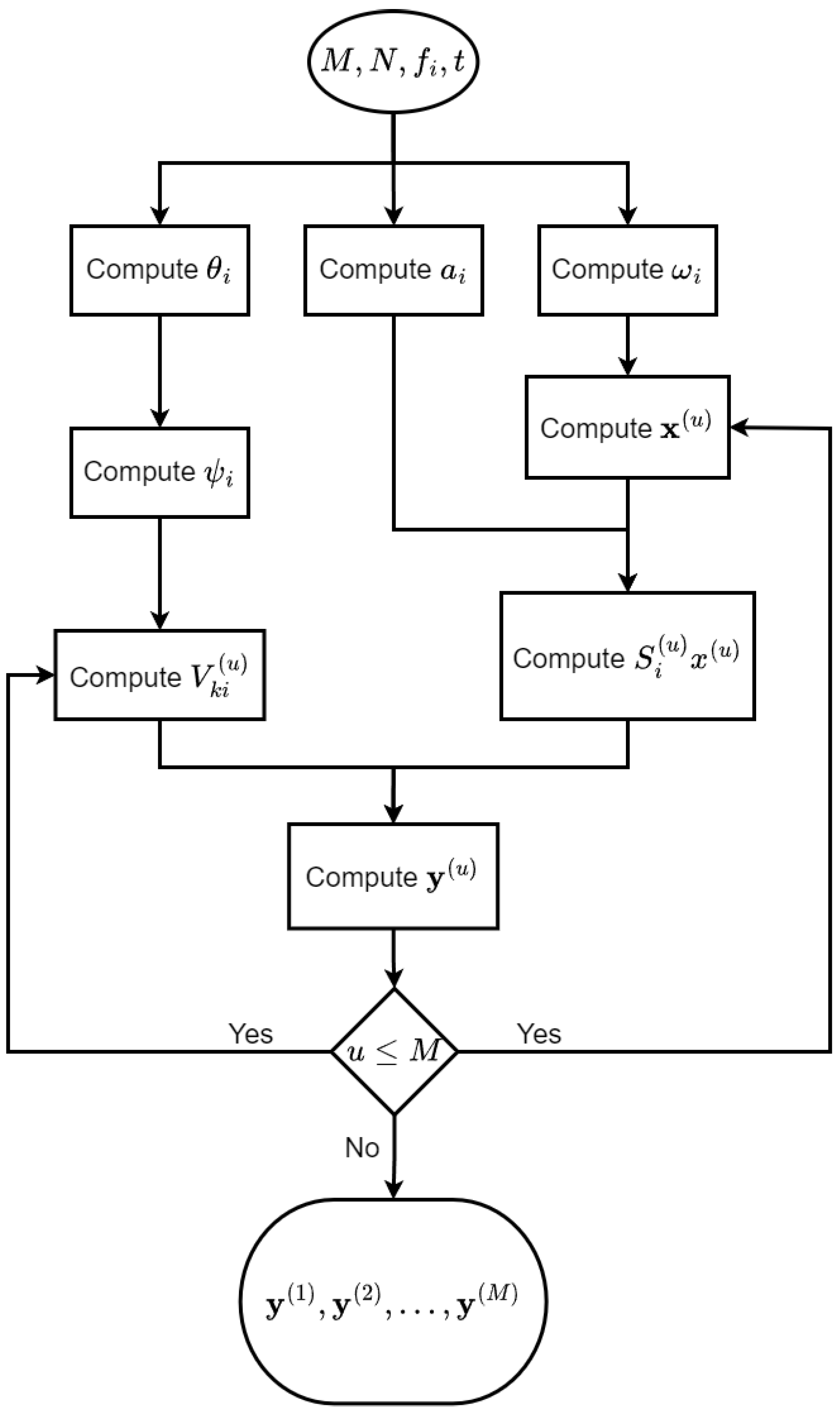
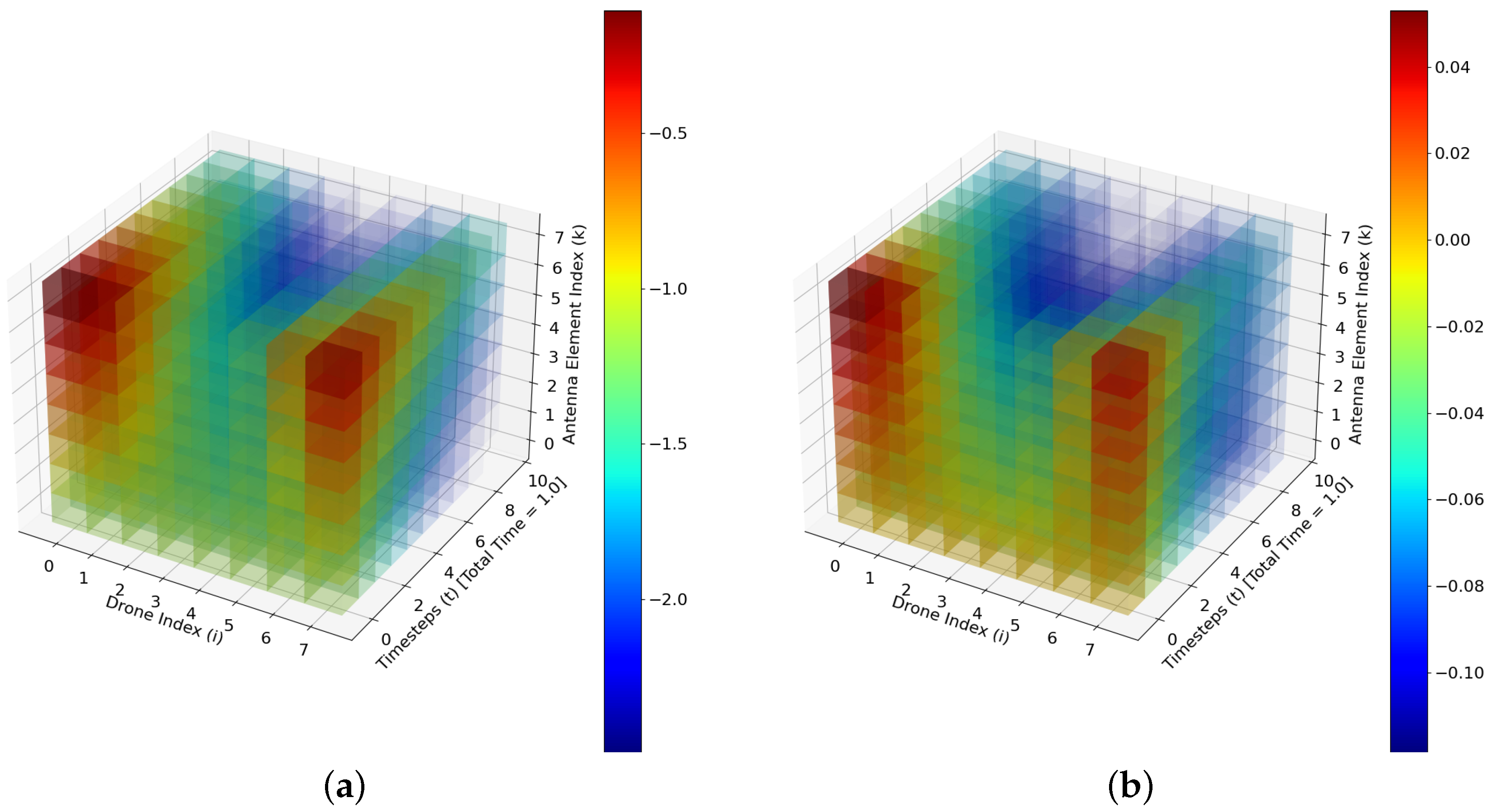
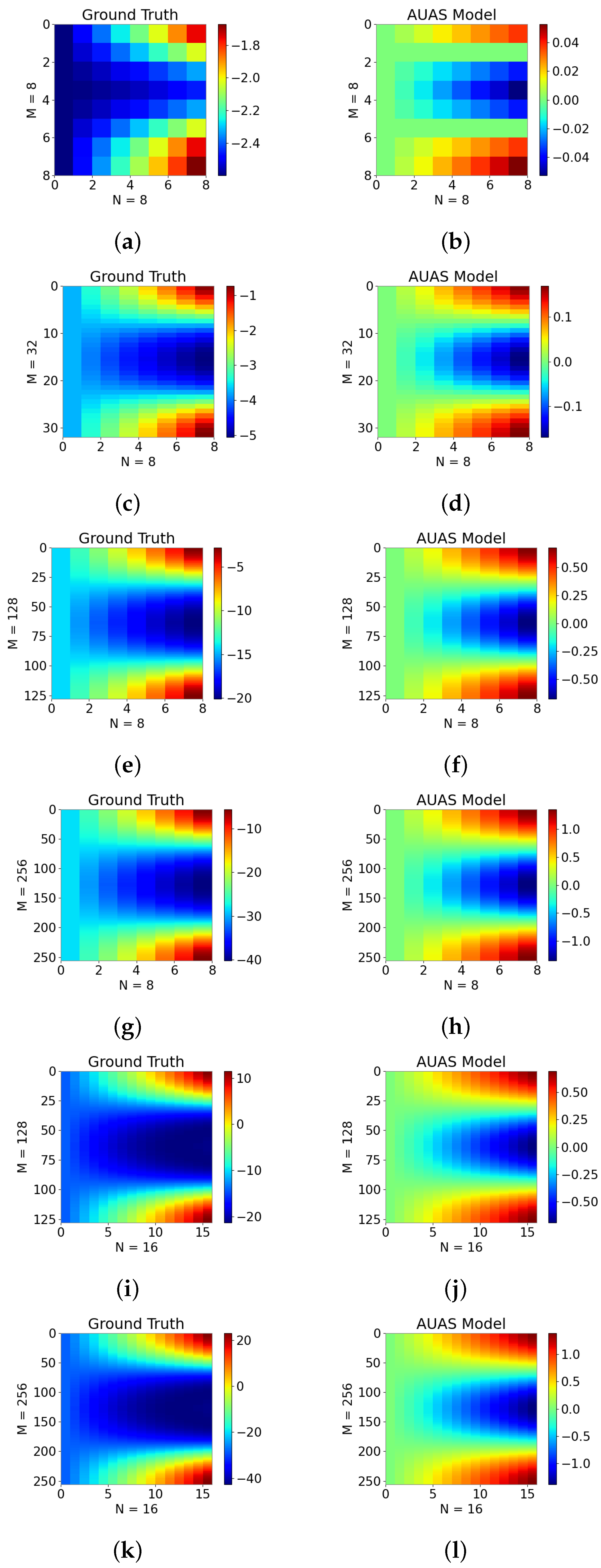
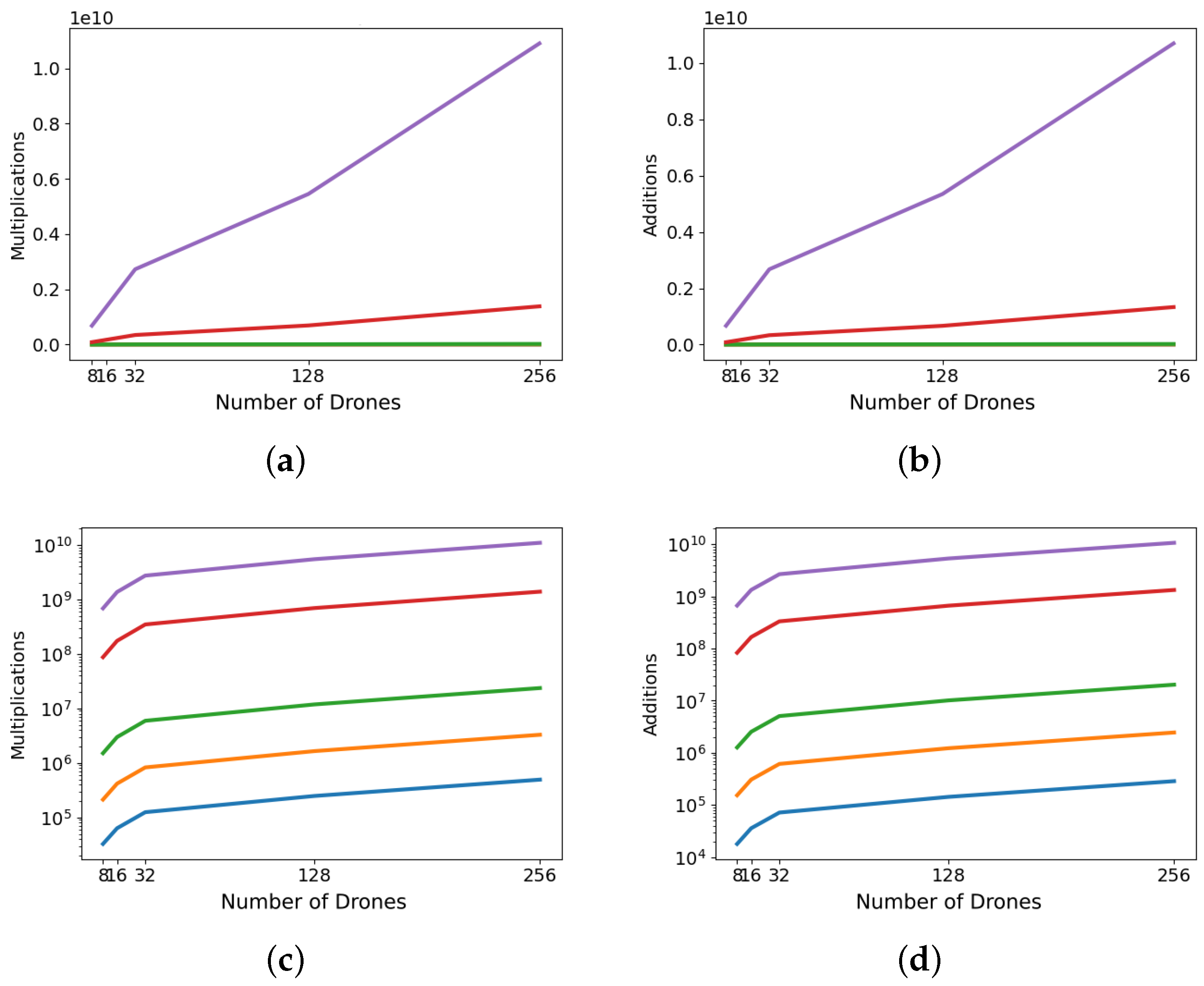
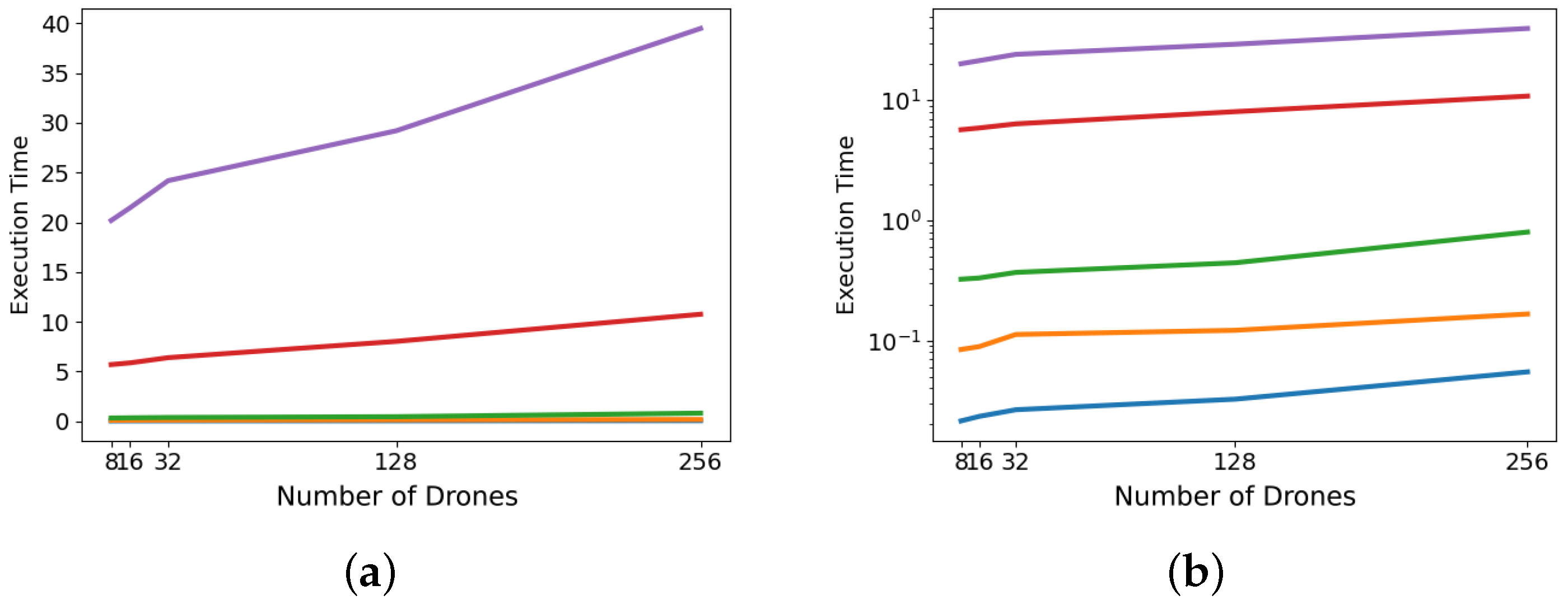
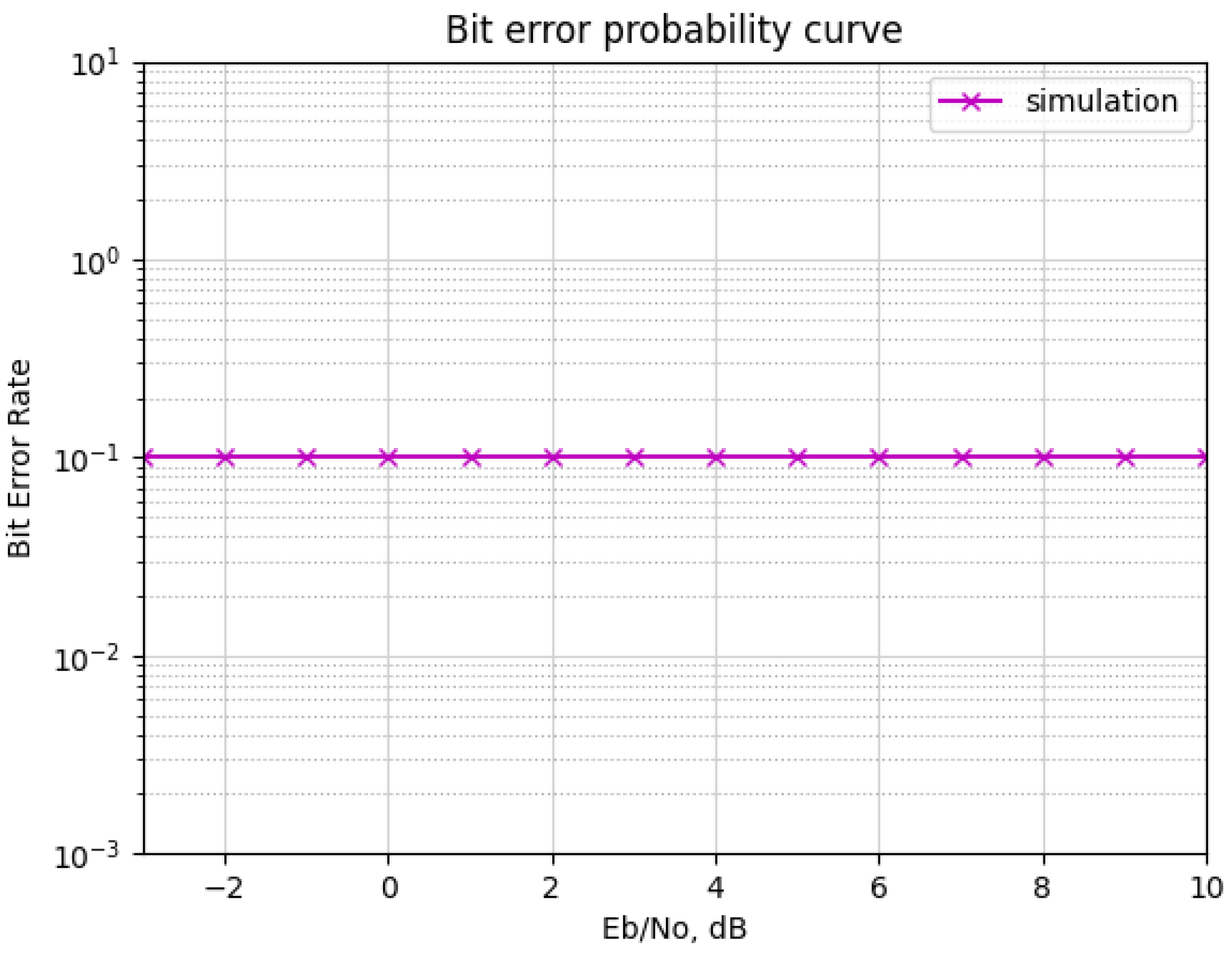

Publisher’s Note: MDPI stays neutral with regard to jurisdictional claims in published maps and institutional affiliations. |
© 2022 by the authors. Licensee MDPI, Basel, Switzerland. This article is an open access article distributed under the terms and conditions of the Creative Commons Attribution (CC BY) license (https://creativecommons.org/licenses/by/4.0/).
Share and Cite
Perera, S.M.; Myers, R.J.; Sullivan, K.; Byassee, K.; Song, H.; Madanayake, A. Integrating Communication and Sensor Arrays to Model and Navigate Autonomous Unmanned Aerial Systems. Electronics 2022, 11, 3023. https://doi.org/10.3390/electronics11193023
Perera SM, Myers RJ, Sullivan K, Byassee K, Song H, Madanayake A. Integrating Communication and Sensor Arrays to Model and Navigate Autonomous Unmanned Aerial Systems. Electronics. 2022; 11(19):3023. https://doi.org/10.3390/electronics11193023
Chicago/Turabian StylePerera, Sirani M., Rodman J. Myers, Killian Sullivan, Kyle Byassee, Houbing Song, and Arjuna Madanayake. 2022. "Integrating Communication and Sensor Arrays to Model and Navigate Autonomous Unmanned Aerial Systems" Electronics 11, no. 19: 3023. https://doi.org/10.3390/electronics11193023
APA StylePerera, S. M., Myers, R. J., Sullivan, K., Byassee, K., Song, H., & Madanayake, A. (2022). Integrating Communication and Sensor Arrays to Model and Navigate Autonomous Unmanned Aerial Systems. Electronics, 11(19), 3023. https://doi.org/10.3390/electronics11193023






